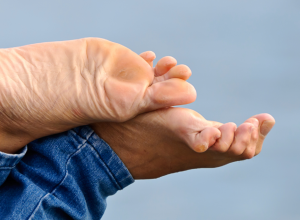
Claw Toe
Claw toe (also called claw foot) is a condition in which a person’s toes bend into a claw-like shape and/or position with the bottom half of the toes pointing up and the tip of the toes pointing down (an imbalance of the extensor tendons in which there is hyperextension at the metatarsophalangeal joint, and flexion at the proximal and distal interphalangeal joints).
Causes
The condition can be present from birth but it can also be caused by ill-fitting shoes, surgery, inflammation, stroke, diabetes, rheumatoid arthritis, cerebral palsy, pes cavus (high arch foot), and other medical conditions. It develops when ligaments and tendons in the foot have tightened, causing the toes’ PIP and DIP joints to curl.
Symptoms
People with the condition have claw-shaped toes that often experience pain and tenderness. Some may frequently develop corns and calluses on the toes that appear from constant friction and rubbing from shoes. In extreme cases, people with claw toes cannot move their toes at all.
Treatment and Prevention
There are two types of claw toes: flexible and rigid. In addition to wearing comfortable shoes with large toe boxes, people with flexible claw toes can relieve some of the foot tenderness and pain by massaging the toes and frequently (but gently) pulling the digits into their original position. Stretching the calves, soles of the feet and metatarsal areas can also help loosen the muscles and alleviate some of the discomfort. Orthotic inserts can also help alleviate symptoms of the condition.
Claw toes can get worse without treatment and may become a permanent deformity over time. And because the condition is often the result of other, more serious diseases, it’s important to see a doctor if you suspect you’re developing the condition. If your toes are still flexible, he or she may suggest you try wearing a splint to reposition the toes. If they are rigid, surgery that will shorten the toe bones may need to be performed.
Claw toes is often confused with another condition called hammertoes, but the two conditions are not the same.
Notice concerning medical entries:
Articles having medical content shall serve exclusively for the purpose of general information. Such articles are not suitable for any (self-) diagnosis and treatment of individual illnesses and medical indications. In particular, they cannot substitute for the examination, advice, or treatment by a licensed physician or pharmacist. No replies to any individual questions shall be effected through the articles.






